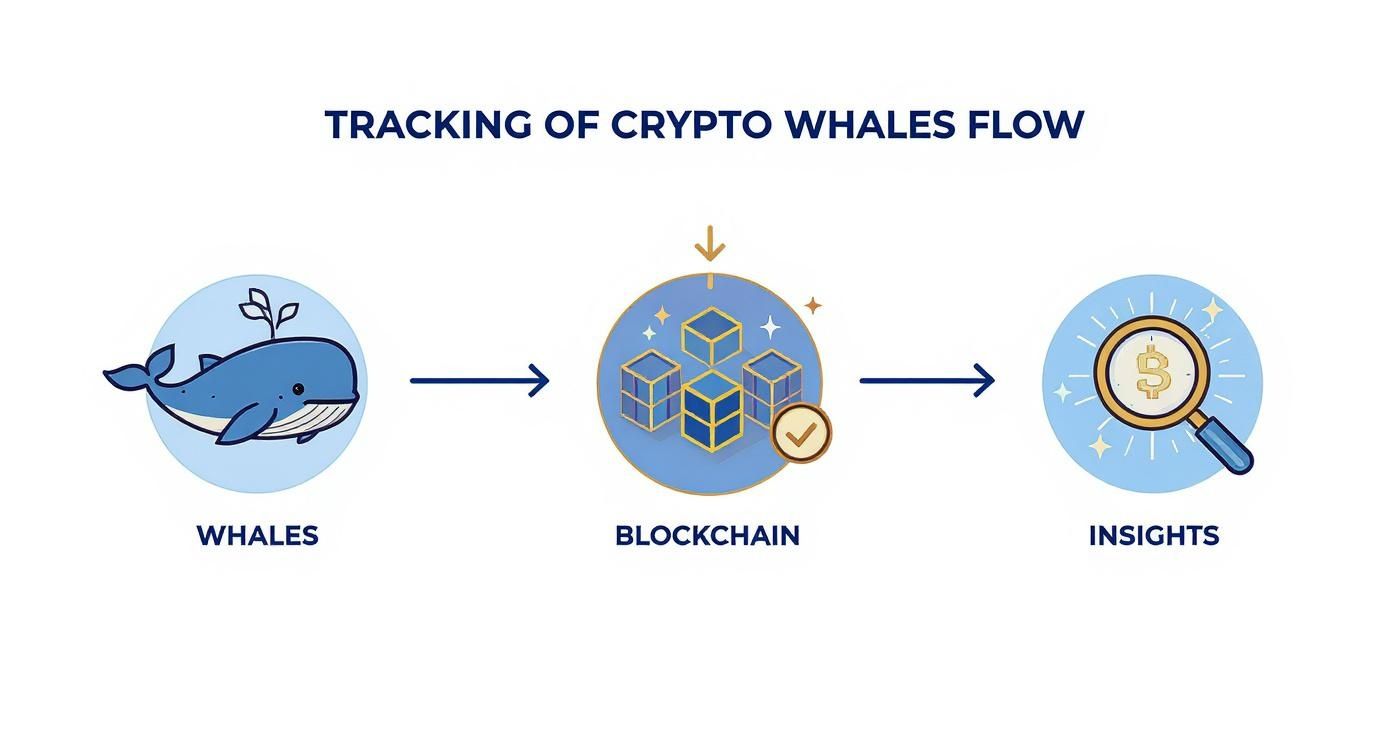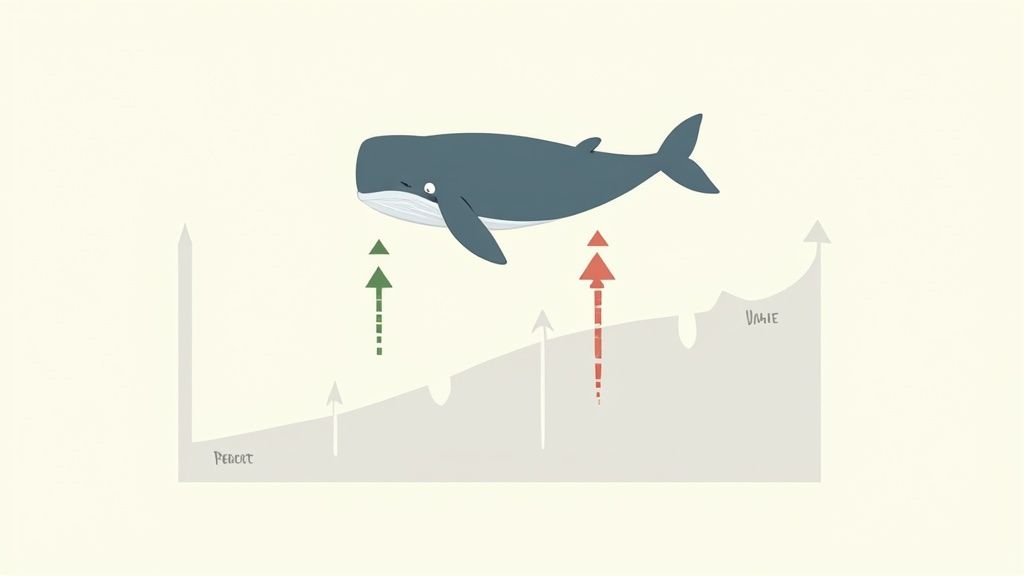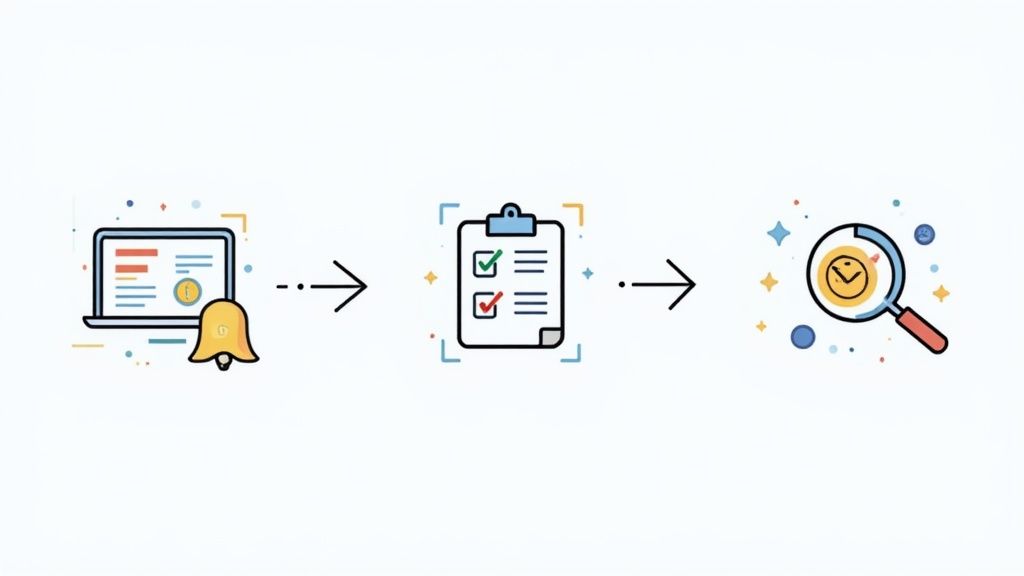Crypto Whales Tracker: A Guide to Smart Trading
Our crypto whales tracker guide helps you decode market signals. Learn to follow smart money, analyze on-chain data, and make more informed trading decisions.

November 19, 2025
Wallet Finder

November 20, 2025

Think of a crypto whale tracker as your personal radar for the blockchain. It's a tool that monitors massive transactions made by the market's biggest players, known as "whales." This gives you a front-row seat to see where huge amounts of money are moving, often before the rest of the market reacts. By watching these moves, you can gain a serious edge in predicting where the market is headed next.
Picture the crypto market as a vast ocean. Millions of small boats—retail investors—make tiny ripples. Then you have the whales, giant cargo ships that can change the direction of the currents for everyone. A crypto whale tracker is built to spot these ships and figure out their destination long before their wake hits the shore.
This isn't about secret, insider information. It's all happening in the open on public blockchain ledgers. The problem? Billions of transactions create an overwhelming wall of noise. A good tracker cuts through that noise to find the signals that actually matter, turning a chaotic mess of raw data into clean, actionable intelligence.
The core idea is simple: whales often know something the average investor doesn't. They have access to better information, conduct deeper research, or are simply ahead of the curve. Tracking their wallets gives you a peek into what the "smart money" is doing. You get to see which tokens are being quietly accumulated or which ones are being moved to exchanges, potentially for a big sell-off. For traders and investors, the advantages are clear and immediate.
A good whale tracker brings several key advantages to your trading strategy. Here’s a breakdown of what it means for you:
So, how does this all happen? At its heart, a crypto whale tracker uses real-time data streaming to constantly process blockchain transactions the second they occur. It scans for unusually large transfers, filters out routine exchange operations, and alerts you when a move looks like a strategic play, allowing you to react fast.
For example, platforms like Whalemap have become essential tools for traders on networks like Ethereum and Base, offering detailed on-chain portfolio analysis. By tracking large wallet inflows, these services help traders pinpoint key support and resistance levels with live alerts. It's all about turning raw data into a real strategic advantage.
Ultimately, using a crypto whale tracker isn't about blindly copying someone else's trades. It's about adding another powerful layer of data to your own decision-making process. It helps you navigate the choppy crypto ocean with more clarity and confidence.
Think of a crypto whale tracker as a detective. The blockchain is the crime scene—a public, transparent ledger of every transaction. The tracker sorts through all the noise to connect seemingly random clues and build a clear picture of what the biggest players are planning. This process turns a chaotic flood of raw data into sharp, actionable trading signals.
The whole system works because every transaction on a blockchain is public. While wallet addresses are just strings of characters, the money trail isn't hidden. A tracker's job is to make sense of this trail by watching, filtering, and analyzing it in real time.
This diagram breaks down how a tracker takes raw blockchain activity and refines it into valuable intel.

As you can see, it’s all about aggregating on-chain data and transforming it into intelligence that helps traders make smarter, more confident moves.
First, you need the data. A whale tracker plugs directly into blockchain nodes—the computers that validate and maintain the network's public ledger. This gives the tracker a live, up-to-the-second feed of every transaction.
Trackers also pull information from block explorers like Etherscan for Ethereum. A block explorer is a search engine for a blockchain, archiving all transaction data. This dual-source approach ensures the data is both real-time and historically complete.
Just having a stream of data is useless. The real magic is spotting the signals that mean something. A good tracker is programmed to flag specific on-chain events that often precede a big market move. These are the "tells" that hint at a whale's next play.
Here are the most common signals a crypto whale tracker looks for:
A rookie mistake is seeing any large transaction as a trade signal. The best trackers can tell the difference between a whale moving funds to sell versus just shifting assets between their own wallets or interacting with a DeFi protocol.
The final step is the most critical: turning raw signals into genuine intelligence. This is where a top-tier crypto whale tracker really proves its worth. It filters out noise—like exchanges moving their own cold-storage funds—and layers in crucial context.
This involves several layers of analysis:
By applying these analytical filters, the tracker doesn't just give you data; it tells you a story. To sharpen your edge, you can dive deeper into using advanced filters for whale wallet tracking to fine-tune your strategy. This is how raw blockchain data becomes your secret weapon.

Seeing a multi-million dollar transaction is one thing. Understanding what it actually means is where the real edge is. A crypto whale tracker gives you the clues, but learning to read the story behind the data is how you start anticipating market moves instead of just reacting to them.
Not all big transactions are created equal. A whale shuffling funds between their own wallets sends a completely different signal than one depositing a huge bag onto an exchange. Knowing the difference turns raw alerts into a real trading advantage.
Whale activity usually fits into a few key patterns, each telling you something different about what might happen next. Once you learn to spot these, you can zero in on the moves that matter.
Here's a quick reference table for decoding whale actions:
The biggest challenge is figuring out if a huge transaction is a genuine market move or just housekeeping. A whale might be moving crypto to a new wallet or sending it to a DeFi protocol to earn yield. These actions don't necessarily signal an impending market dump.
The best crypto whale tracker platforms solve this puzzle with sophisticated wallet labeling. By identifying and tagging addresses that belong to exchanges, VCs, and DeFi contracts, they give you instant context for every transaction.
For example, a $50 million ETH transfer from "Binance Hot Wallet" to "Coinbase Cold Storage" is likely just an inter-exchange shuffle. But if an unlabeled wallet that's been dormant for six months suddenly sends that same amount to Binance? That's a high-priority alert.
By combining on-chain data with classic market analysis techniques, like studying Wyckoff Distribution Patterns to spot when smart money is quietly exiting, you build a much richer picture of what's happening. This lets you move from reacting to alerts to proactively anticipating the market's next big move.

Knowing what whale signals mean is a great start, but the real edge comes from turning that knowledge into a concrete trading strategy. A crypto whale tracker isn't just for watching; it's a tool for making proactive moves. Weaving it into your daily routine can completely change how you handle risk, spot opportunities, and validate your market instincts.
One of the most powerful ways to use a whale tracker is for risk management. Major price drops are often telegraphed by whales moving massive stacks of coins to centralized exchanges. Setting up the right alerts can give you a heads-up before the selling pressure hits.
Here’s an actionable checklist to get started:
When an alert hits, it's not an automatic signal to panic-sell. It's your cue to investigate. This alert gives you a crucial head start to size up the situation and protect your capital.
A whale tracker isn't just for defense; it's an incredible tool for finding new opportunities before they hit the mainstream. Whales often quietly accumulate promising new tokens, and spotting this pattern can point you toward undervalued gems.
By watching the wallets of historically successful traders—those with a high P&L and win rate—you can see which new narratives or ecosystems are attracting "smart money" before the hype cycle begins.
The strategy is to look for sustained accumulation in up-and-coming tokens, especially those with lower liquidity where big buys have an outsized impact. Monitoring these moves helps you decode what 'smart money' is thinking. For a deeper look at this, check out TokenMetrics' deep dive on the subject.
Every trader has been there: you've done the research and built a solid thesis, but doubt remains. A whale tracker can be the final confirmation you need to act with confidence.
Let's say you're bullish on a token. Before you jump in, use your tracker to answer one critical question: what is the smart money doing?
Here's a simple way to think about it:
Using a crypto whale tracker this way doesn't replace your own research. Instead, it adds a powerful layer of data-driven proof, helping you make smarter, more confident decisions.
With so many crypto whale trackers out there, picking the right one can feel overwhelming. Not all platforms are created equal. The key is to find a tool whose features align with your specific trading style, goals, and budget.
It’s not about finding the tracker with the most features, but the one with the right features for you. A cluttered dashboard is just noise. Your goal is to find a platform that delivers clear, relevant insights that help you act fast and with confidence.
When sizing up different whale trackers, a few features are non-negotiable. Think of this as your must-have checklist:
Beyond the basics, a few other things can make or break a tracker's usefulness. These often separate free, basic tools from professional platforms.
For example, having access to rich historical data is a game-changer. It lets you check a whale’s track record to see if they’re actually “smart money.” A clean, intuitive user interface (UI) is just as important—complex data is worthless if it’s presented in a confusing way.
The ultimate goal is to find a platform that feels like a natural extension of your trading workflow. It should save you time, reduce uncertainty, and empower you to make more informed decisions without creating information overload.
This table breaks down what to look for in a top-tier crypto whale tracker and explains why each feature is so important.
By carefully weighing these features, you can confidently pick a crypto whale tracker that fits you like a glove. This decision is fundamental to building a solid strategy, which we dive into in our guide on how to track smart money across blockchains. The right tool will give you the clarity and insights you need to navigate the crypto markets like a pro.
Jumping into on-chain analysis can feel like drinking from a firehose. You hear about crypto whale trackers being a game-changing technique, but it’s normal to have questions about legality, effectiveness, and common pitfalls. This section provides straight, no-fluff answers.
Yes, 100% legal and ethical. Blockchains are public, open ledgers by design. Every single transaction is recorded for anyone to see.
Analyzing this data is no different from a stock trader reviewing public SEC filings. You're not accessing private keys or personal information. You're simply observing pseudonymous activity on a public network—a core principle of crypto.
No tool can ever guarantee profits. A high-quality whale tracker is an incredibly powerful analytical tool that gives you an informational edge, not a magic crystal ball.
Whales make mistakes, and their investment timeline might be years while yours is days. The smart way to use this data is as one piece of a bigger puzzle that includes your own research, technical analysis, and rock-solid risk management.
A whale tracker is a compass, not a treasure map. It shows you the direction smart money is heading, but you still have to navigate the journey yourself.
This is a great question and a primary problem a good tracker solves. Cutting-edge platforms use sophisticated labeling systems to filter out noise. They identify and tag addresses belonging to centralized exchanges (CEXs), DeFi protocols, and other known entities.
For example, a wallet with thousands of small, unrelated transactions daily is almost certainly an exchange hot wallet. But a wallet that makes a few huge, strategic moves per month? That's far more likely to be an individual whale or a crypto fund. This filtering lets you focus on the signals that matter.
Knowing what not to do is just as important as knowing what to do. Avoiding these common traps can save you time, stress, and money.
The single biggest mistake is blindly copying a whale's every move. A massive transfer to an exchange doesn't automatically mean a dump is imminent. It could be for staking, providing liquidity, or other reasons. Context is king.
Here are a few other pitfalls to watch for:
Ready to turn on-chain data into your competitive advantage? Wallet Finder.ai gives you the tools to discover, track, and mirror the moves of top-performing crypto wallets in real time. Start your 7-day trial and see what the smart money is doing. Find your edge today at https://www.walletfinder.ai.
"I've tried the beta version of Walletfinder.ai extensively and I was blown away by how you can filter through the data, and the massive profitable wallets available in the filter presets, unbelievably valuable for any trader or copy trader. This is unfair advantage."
.avif)
Pablo Massa
Experienced DeFi Trader